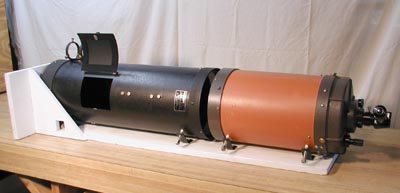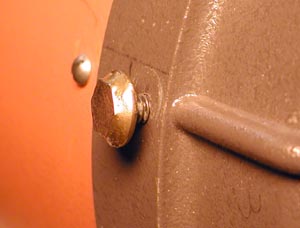Special Equipment for Focusing the Celestron/Epoch Schmidt Camera

As we shall see in the next section, an infinity-focused telescope is an
essential tool for setting the focus of a Schmidt camera. If a
Schmidt-Cassegrain telescope is used for the focus procedure, the telescope
must be modified to prevent the telescope from changing focus after being
set to infinity. This is difficult with the Schmidt-Cassegrain design
because the telescope focuses by moving the primary mirror up or down the
central light baffle protruding through the Cassegrain hole in the mirror.
As the telescope is handled, the loose tolerances in the mirror mount allow
it to rock slightly as the telescope's attitude changes from vertical to
horizontal. This slight movement is enough to dislodge the infinity focus. A
method must be devised to securely lock the mirror in place to guarantee
infinity focus is maintained.
 The Celestron-8 guide scope that I use in conjunction with my Schmidt camera
was modified to lock its mirror in order to prevent guide star movement if
the mirror shifts. This was accomplished by adding three plastic strips at
120-degree intervals inside the tube next to the edge of the mirror.
Setscrews protruding through the telescope tube can be screwed inward to
press on these plastic strips so they contact the edge of the mirror, thus
holding it firmly in place. These plastic strips were fabricated from thin
flat plastic salvaged from a scrap plastic spool that used to hold
electrical wire. The strips were installed by lowering the mirror as close
to the rear of the scope as possible to get it out of the way, them removing
the corrector plate to allow access inside the tube. Holes were then drilled
into the tube to secure the top of the plastic strips so they lay parallel
to the optical axis. Another hole was drilled and tapped next to the strips
further down the tube. A ¼ setscrew was then installed so when it is screwed
inward, it gently pushes the plastic strip against the edge of the mirror.
The Celestron-8 guide scope that I use in conjunction with my Schmidt camera
was modified to lock its mirror in order to prevent guide star movement if
the mirror shifts. This was accomplished by adding three plastic strips at
120-degree intervals inside the tube next to the edge of the mirror.
Setscrews protruding through the telescope tube can be screwed inward to
press on these plastic strips so they contact the edge of the mirror, thus
holding it firmly in place. These plastic strips were fabricated from thin
flat plastic salvaged from a scrap plastic spool that used to hold
electrical wire. The strips were installed by lowering the mirror as close
to the rear of the scope as possible to get it out of the way, them removing
the corrector plate to allow access inside the tube. Holes were then drilled
into the tube to secure the top of the plastic strips so they lay parallel
to the optical axis. Another hole was drilled and tapped next to the strips
further down the tube. A ¼ setscrew was then installed so when it is screwed
inward, it gently pushes the plastic strip against the edge of the mirror.
 To perform the optical focusing procedure, I made the handling fixture to
hold the Schmidt camera and the telescope horizontal relative to each other.
For those not inclined to go through this effort, the focus procedure can be
done on a tabletop using large books to keep the optical tubes from rolling.
To perform the optical focusing procedure, I made the handling fixture to
hold the Schmidt camera and the telescope horizontal relative to each other.
For those not inclined to go through this effort, the focus procedure can be
done on a tabletop using large books to keep the optical tubes from rolling.
 To fabricate the holding fixture I made eight 45-degree brackets out of
one-inch strap steel. These are attached to a 44-inch long piece of 1 X 10
shelf lumber. The brackets have a threaded hole in them so a 5/16
coarse-thread two-inch long jackscrew can pass through them. Four of these
each supports the telescope and the Schmidt camera fore and aft at about 90
degrees apart around the bottom of the tube as they lay horizontally. The
jackscrews have three layers of masking tape covering their tips so they
don't scar the paint on the optical tubes. The jackscrews are adjusted to
level the two tubes and align them so they are parallel and on-axis with
each other. Once the focus at the center of the film holder has been
confirmed, these jackscrews allow the telescope to be slewed off-axis
relative to the Schmidt camera so the focus at the edges of the film holder
can be checked. This is necessary because the film holder might be tipped,
rendering the edges of the field out of focus even if the center is in
focus.
To fabricate the holding fixture I made eight 45-degree brackets out of
one-inch strap steel. These are attached to a 44-inch long piece of 1 X 10
shelf lumber. The brackets have a threaded hole in them so a 5/16
coarse-thread two-inch long jackscrew can pass through them. Four of these
each supports the telescope and the Schmidt camera fore and aft at about 90
degrees apart around the bottom of the tube as they lay horizontally. The
jackscrews have three layers of masking tape covering their tips so they
don't scar the paint on the optical tubes. The jackscrews are adjusted to
level the two tubes and align them so they are parallel and on-axis with
each other. Once the focus at the center of the film holder has been
confirmed, these jackscrews allow the telescope to be slewed off-axis
relative to the Schmidt camera so the focus at the edges of the film holder
can be checked. This is necessary because the film holder might be tipped,
rendering the edges of the field out of focus even if the center is in
focus.
 The Schmidt camera end of the fixture has a board attached to it at 90
degrees so the whole thing can be tilted and set up on end with the
telescope looking down into the Schmidt. This might be needed to simplify
working through the film-loading door while working with the focus
adjustments. The base of the Schmidt then sits on the 90-degree board and is
held against the jackscrews with bungee cords. The nose of the telescope
rests on a 1/4-inch bolt protruding from the baseboard and its tube is also
held on the jackscrews with bungee cords.
The Schmidt camera end of the fixture has a board attached to it at 90
degrees so the whole thing can be tilted and set up on end with the
telescope looking down into the Schmidt. This might be needed to simplify
working through the film-loading door while working with the focus
adjustments. The base of the Schmidt then sits on the 90-degree board and is
held against the jackscrews with bungee cords. The nose of the telescope
rests on a 1/4-inch bolt protruding from the baseboard and its tube is also
held on the jackscrews with bungee cords.

Go to the previous page ---- Adjusting
Mirror Collimation
Go to the next page -------- Checking
Camera Focus








